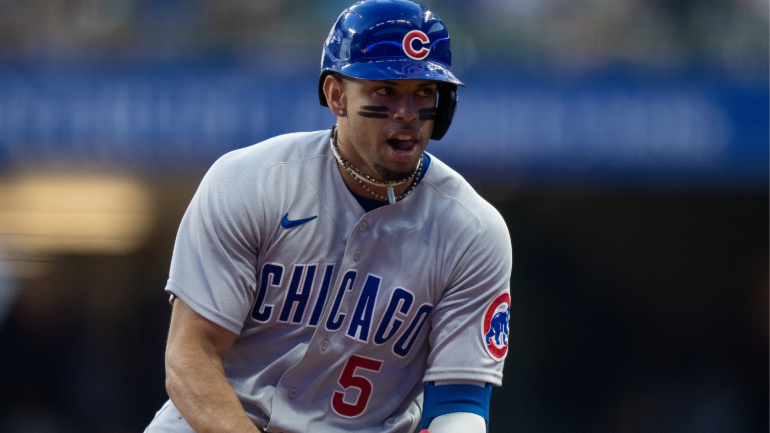
Following along with the rumor mill this time of the year is often an exercise in futility. The Winter Meetings, in particular, serve as a reminder that not all information is good information. (Indeed, sometimes teams leak bad intel to identify the sources of leaks or to influence negotiations.) Still, if you've been trying to sort the wheat from the chaff this week, you may have noticed that one name keeps popping up whenever the Chicago Cubs are involved.
Christopher Morel, a 24-year-old utility player with 220 games to his credit, has been mentioned with respect to the Cubs' real or theoretical pursuits of Rays righty Tyler Glasnow, Mets slugger Pete Alonso, and Padres star Juan Soto. To think, those are just the publicly rumored connections. Front-office sources often grow coy when it comes to players on their radar; when CBS Sports asked one talent evaluator, whose team has not been connected to Morel this winter, about him, all they offered was that he was "interesting."
What makes Morel intriguing, and why does it feel like a fait accompli that the Cubs will trade him this winter to land a star? Scroll slowly with us to find out.
What makes Morel interesting?
Let's start with the obvious. Morel has proven himself to be a productive hitter in those aforementioned 220 games. He's batted .241/.311/.471 (110 OPS+) with 42 home runs and 16 stolen bases. His contributions have been worth an estimated 2.4 Wins Above Replacement, per Baseball-Reference. That number may undersell him and his true value to a club, in our estimation.
WAR has several shortcomings, including an inability to accurately capture the significance of extreme defensive versatility. Morel doesn't grade well at every position, but the Cubs have entrusted him to clock in 69 times in center field; 52 times at second base; 23 times at third; and 15 times at shortstop. Being able to slot in like that comes in handy, even if his glove plays a little light.
Some other aspects Morel has working in his favor are his age (he won't celebrate his 25th birthday until next June) and his ball-tracking data.
Christopher Morel is the first Cub in franchise history (since 1901) to record eight home runs in the first 11 games of a season! pic.twitter.com/zwZWl3NSw3
— Chicago Cubs (@Cubs) May 21, 2023
Last season, more than 50% of Morel's batted balls had an exit velocity of 95 mph or more. For reference, only 14 qualified batters in 2023 had a higher percentage of hard-hit balls -- and it's a who's who of big-league hitters that includes Shohei Ohtani, Juan Soto, Ronald Acuña Jr., Matt Olson, Corey Seager, and Gunnar Henderson, among other star-level performers. You don't have to care about exit velocity to concede that's good company to keep.
Besides, it's not just that Morel hits the ball with authority, either. He also hits it on a line. His average launch angle on those hard-hit balls was 15 degrees. That puts him in the same neighborhood as Marcus Semien, Austin Riley, and Luis Arraez. There is an undesirable part of Morel's offensive game that we'll touch on below, but it's within reason to expect him to remain an above-average hitter capable of providing right-handed thump.
Factor in Morel's ability to stand on the dirt or grass alike, and that talent evaluator is correct in assessing him as an "interesting" player. So, why would the upstart Cubs be willing to move him, anyway?
Why would the Cubs trade Morel?
As the old parlance goes, you have to give up something to get something. Morel is an intriguing young talent, but it's not hard to understand that teams use different calculuses when dictating trade value. The Cubs have more financial resources than a team like the Rays do. They also have plenty of depth at the positions he's most likely to occupy as a regular. Dansby Swanson and Nico Hoerner are secure up the middle; Ian Happ and Seiya Suzuki are locked in as corner outfielders; Pete Crow-Armstrong is ready to take over in center field, depending on what the Cubs do the rest of this winter; and first-round pick Matt Shaw will soon find some place on the infield to make his own.
In theory, Morel could take up first base or DH, or he could simply come off the bench. Those solutions don't maximize his multi-positional ability, however. And, while there's value in having a player who can slot in wherever on a moment's notice, that's a luxury that the Cubs may value less than having a top-of-the-rotation starter, or a top-end middle-of-the-order bat.
A little more Morel?
— Chicago Cubs (@Cubs) September 15, 2022
Just for you. pic.twitter.com/Ez2QhRQU0m
There's also the "undesirable" part of Morel's game that we hinted at above: his contact woes. He struck out in nearly 32% of his career plate appearances, and that's not by accident. His 63.8% contact rate ranked near the bottom of the majors. It's more acceptable these days to whiff that often, and Morel certainly has the quality-of-contact chops to make it work for him. Even so, it's always difficult to peg how feast-or-famine hitters are going to fare over the longer haul, when they begin to lose bat speed or barrel control.
We wrote above that we think Morel will remain an above-average hitter. Two things can be true at once: we can hold that evaluation while conceding that the error bars around his bat are likely to grow wider into his late 20s. If you're the Cubs, then, you might see this as the peak of Morel's value. Teams know he's a good hitter, and they can envision him being the immediate solution to a problem the Cubs themselves do not have. For now, that matters more than what could go wrong down the road.
Add it all together, the pros and the cons and the motivations, and you can understand why Morel has become a walking trade rumor this winter.


















